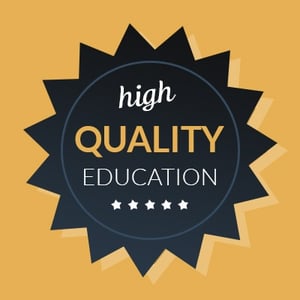
In my March blog, The Access vs. Quality Debate in Early Childhood Education, I discussed the ongoing debate in early childhood education systems building about increasing access or increasing quality. One thing I failed to do was provide a definition for “quality” early childhood education. I am not alone in this omission. If you were to review most federal, state, and local legislation on early childhood education, you would see a void in defining the word quality. I would argue that this lack of clarity around a central word severely impacts our ability within the nation, state, or locality to move forward in early childhood education systems building. Without a central definition to strive for, to drive for, and to focus upon, it is nearly impossible to build the infrastructure needed to build a quality system.
Those of you that have attended meetings or conference presentations with me have heard me talk about the power of defining central words in our discussions, writings, or plans to ensure that there is no misunderstanding or miscommunication. A common definition enables everyone to use a common language and lens, as well as to have a central starting point for change.
Therefore, in this series of blogs I am inviting my fellow Teachstone blog contributors as well as national and state experts to join the discussion to define quality. In future blot posts, I will also share relevant research and popular press articles to support our discussion. I invite you to join the discussion by posting comments to this blog post, as well as by holding bag lunch forums, discussion groups, and team meetings in your centers and communities around the definition of quality.
I will start the discussion of with my definition quality. My factors of quality come from my years in the profession wearing many hats as a teacher, administrator, coach, teacher educator, and researcher. As with everything I think about, my definition takes what is found in research and best practice, compares it to what is occurring on the ground in classrooms and centers, and finds a central tipping point to quality.
Factor #1: Teacher-Child Interactions:
I would not be the Chief Strategy Officer of Teachstone if I did not believe that the central factor in classroom quality is the moment by moment interactions that occur on a daily basis between teachers and students. Through the CLASS framework, these interactions can now be behaviorally defined and observed in a range of social and instructional activities in classrooms. Research shows that increasing the quality of teacher interactions with children is the single most impactful investment that can be made to improve classroom quality.
Factor #2: Evidenced-based Curriculum:
Effective teacher-child interactions are essential but they must be tied to the use of an evidenced-based curriculum in every classroom. This does not mean that classrooms have a curriculum that sits on the shelf. This means that the teacher has received sufficient, appropriate professional development on the curriculum, has all the materials needed to effectively implement it, and uses it on a daily basis in lesson planning and teaching.
Factor #3 Aligned Early Learning Standards:
Early learning standards provide targets or guidelines for teachers and programs to use to help students to reach developmental goals that prepare them for future learning. These standards need to be developmentally appropriate, easy to understand, and objective. Most important, they need to be concise and focused. Too many state standards are so detailed and lengthy that they are nearly impossible for a teacher to get her head around to use as an active teaching and learning resource.
Factor #4: Targeted Professional Development:
Speaking of professional development, teachers need sustained, targeted professional development that is aligned to program goals and practices, yet differentiated to her skill level and needs. This must occur in a continuum that includes classroom observation, feedback, and professional development.
Factor #5: Full Day Programming:
As a working mom since the time my children were six weeks old, I know that families need education programs that provide full-day coverage. Part-day programs without appropriate wrap-around care do not give families the support they need. In addition, full-day programs provide the greatest educational benefit to children in terms of long-term social and cognitive gains. The number of state-funded prekindergarten programs that only provide two to four hours of programming for students discourages me.
Factor #6: Family Engagement:
Ensuring that families are considered partners in the education of their children and supported in their social, emotional, and educational growth continues to be an important factor. Programs cannot just give lip service to engagement; it needs to be a central factor in program philosophy.
Factor #7: Effective Leadership:
To bring these six factors together, programs need effective leaders with training and experience in both the business side of managing a program and the education side of supporting teachers as an instructional leader. This includes the ability to understand, analyze, and utilize data in the management of their programs, as well as the ability to motivate staff.
These are my seven factors. For now, I am staying out of the credential and degree debate as I am on the fence regarding the impact these have on quality.
What am I missing? What did I not consider? How do I align to your definition of quality? Please join the discussion by commenting, blogging, or sharing in your community.
Until next time,
Rebecca

